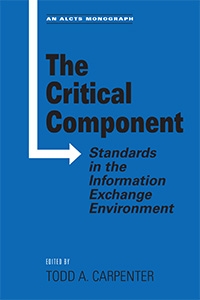Primary tabs
You don't need to be an ALA Member to purchase from the ALA Store, but you'll be asked to create an online account/profile during the checkout to proceed. This Web Account is for both Members and non-Members.
If you are Tax-Exempt, please verify that your account is currently set up as exempt before placing your order, as our new fulfillment center will need current documentation. Learn how to verify here.
- Description
- Table of Contents
- About the author
While most of us are generally unaware how critical they are, standards make twenty-first century libraries, information services, and publications of all kinds work. In this environment, everyone working with systems, circulation, resource sharing, digital initiatives, preservation, collections or special collections, and even public services can benefit from learning more about standards.
An improved understanding of standards, on which librarians rely, will lead to greater application and adoption of these technologies. By better understanding how standards are developed, more librarians can turn to the standards process when they have ideas for how to improve their work. The Critical Component: Standards in the Information Exchange Environment paints a complete picture of information standards in 11 chapters and 9 case studies, which provide:
- an overview of standards and their benefits to libraries and other cultural organizations
- the process of developing, approving, and maintaining formal standards
- players in the information landscape
- basic standards concepts
- specific purposes of standards, including identifiers, description, discoverability, and preservation
- an overview of how new standards are marketed and adopted
- ways that individuals can get involved in standards work
- a look at the future of standards
The ongoing educational, research, and entertainment missions of libraries and other cultural organizations rely on standards that underlie interoperability and data exchange, unique identifiers and authority control, ontologies, barcodes, patron management, resource sharing, discovery, web-based services, software, digital collections, preservation, metadata management, bibliographic control, and resource layout. Greater understanding of and appreciation for these information standards that permeate our work and our institutions will only help us and our institutions.
Introduction
Cindy Hepfer
Chapter 1. The Value of Standards for Information Exchange
Todd A. Carpenter
Chapter 2. How Formal Should We Be? The Standards Continuum and the Standards Development Pipeline
Cynthia Hodgson
Case Study. The Digital Object Identifier: From Ad Hoc to National to International
Norman Paskin
Chapter 3. The Information Standards Landscape
Nettie Lagace
Case Study. Everything Old is New Again: ISSN in the Digital Environment
Regina Romano Reynolds
Chapter 4. Basic Standards Concepts
Mark Bide
Case Study. Accessibility for Everyone
George Kerscher
Chapter 5. This Thing Is Not That Thing: The Role of Identifiers in Content Management and Distribution
Laura Dawson
Case Study. I2 and ISNI: Expanding the Use of an Identifier to Serve Multiple Needs
Janifer Gatenby
Chapter 6. Describing Resources for Discoverability and Reuse
Diane I. Hillmann
Case Study. Development of Dublin Core
Thomas Baker
Chapter 7. Discoverability: The Ultimate Goal
Marshall Breeding
Case Study 7. Providing Appropriate Access
Adam Chandler
Chapter 8. Ensuring Digital Preservation for Future Generations
Lisa Gregory
Case Study. Portico: Using Standards for Scholarly Content Preservation
Kate Wittenberg, Sheila Morrissey, and Amy Kirchhoff
Chapter 9. Marketing Your Standard from Idea to Brand to Practice
Heather Staines and Robert Boissy
Case Study. EPUB 3: The Birth and Adolescence of an Unusually Visible Standard
Bill Kasdorf
Chapter 10. Getting Involved with Standards
Ted Koppel
Case Study. How One Standard—COUNTER—Drove the Need for Another—SUSHI
Oliver Pesch and Peter Shepherd
Chapter 11. The Future Need for Standards Will Only Expand
Todd A. Carpenter
Todd A. Carpenter
Todd A. Carpenter is executive director of the National Information Standards Organization (NISO). Todd brings to this role more than twenty years of publishing, digital content distribution, business development, and library community experience.



